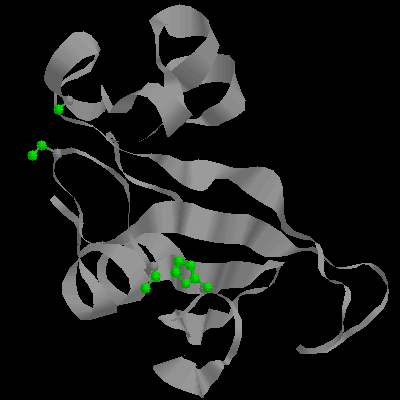 These barnase structures
and their pdb links are shown here.
These barnase structures
and their pdb links are shown here.Disulphide bonds are formed by the oxidation of two cysteine residues to form a covalent sulphur-sulphur bond which can be intra- (examples are shown in Jane Richardson's Protein Tourist kinamage) or inter- (exemplified by insulin at this PPS link) molecular bridges.
One might imagine that as the enthalpy of a covalent disulphide bond is very high, it contributes a great deal to stability. However, this bond is present in both the folded and the unfolded state, thus its enthalpic contribution to the free energy difference is negligible. All of the stabilizing effect of a disulphide bond is proposed to come from the decrease in conformational entropy of the unfolded state, as described in Conformational Entropy of Unfolding, above.
Calculations suggest that a disulphide bond should give rise to 2.5 - 3.5 kcal/mol of stabilization, depending on the primary sequence separation between the crosslinks (Braxton, 1996). Experiments in which naturally occurring disulphides are either mutated to alanine, or chemically reduced and blocked, lead to decreased stability ranging from 2 - 8 kcal/mol (Betz, 1993 and references therein). Unfortunately, because these experiments also leave cavities, or buried polar groups, or otherwise have more consequences than just removal of the disulphide bridge, it is hard to estimate the stabilization due to crosslinks alone.
Introduction of novel disulphides into proteins has also had mixed results. Five disulphides have been introduced into T4 lysozyme (which has no disulphides in the wild-type). Two are destabilizing, and three are stabilizing relative to their reduced form, but all five are destabilized relative to wild-type (Betz, 1993)! However, there have been successful stabilizations by introduction of disulphides: The stability of RNase Hn is increased by 2.8 kcal/mol upon introduction of a disulphide. Engineering disulphides into the ribonuclease barnase gave rise to increased stability of 1.2 and 4.1 kcal/mol (Clarke et al., 1995). Interestingly, the former disulphide encompasses a loop of 34 residues, while the latter encompasses 17.
 These barnase structures
and their pdb links are shown here.
These barnase structures
and their pdb links are shown here.
If the stabilization is purely due to conformational entropy, the magnitude of stabilization would be the opposite way round; further, the degree of stabilization observed for the 17 residue loop (4.1 kcal/mol) is higher than would be predicted by the theory (Betz, 1993 ). Thus, it is clear that we are still far from understanding the role of disulphides in protein structure.
It is worth noting that small proteins are often naturally rich in disulphide bonds (examples are shown in Jane Richardson's Protein Tourist kinamage); perhaps, when the geometry is optimal, they compensate for the small number of non-covalent interactions.
Disulphide linkages are rare in hyper-thermostable proteins, presumably because they are chemically labile at high temperatures (see Chemical Degradation below).
Disulphides can also contribute a great deal to Kinetic
Stability (below).
![]() Metal Binding
Metal Binding ![]() Kinetic Stability
Kinetic Stability![]() Beginning
Beginning